Etude

More companies are turning to zero-based budgeting but enjoying it less.
A recent global Bain & Company survey found that a growing number of companies facing pressure to cut costs are deploying this proven cost and capability-changing tool. In the Asia-Pacific region, for example, fully 80% of executives interviewed for a 2015 report said they expected to implement zero-based budgeting programs—a huge jump from 13% a year earlier. Globally, four times as many companies were anticipating such initiatives (see Figure 1). But if history repeats itself, their rates of satisfaction will be low. Less than half of all large companies (with more than $2 billion in sales) reported success from their efforts. For medium-sized companies, rates were better, with 76% indicating that they were satisfied or very satisfied with the results.

Beyond Zero-Based Budgeting
A look at common zero-based budgeting mistakes and how to avoid them.
However, the numbers get interesting when you look at what led to positive outcomes. Companies that used zero-based budgeting as part of a comprehensive effort were nearly twice as likely to say they were satisfied or very satisfied with the results as their counterparts who pursued limited initiatives. In our experience, the most successful outcomes use zero-based budgeting in concert with an approach to organizational and business process simplification that we call zero-based redesign. In contrast, companies that deploy zero-based budgeting solely for the lure of cost cutting run a double risk: They can cut into growth muscle and hurt the customer experience.
When fully implemented, zero-based budgeting can reawaken a company’s ownership mindset, eliminating the clutter that makes it hard for employees to do their jobs and simplifying the organization and practices that frustrate results-oriented high performers. A simple example: Before 3G Capital used a zero-based system to clarify roles and objectives, eliminate layers and standardize processes at Kraft-Heinz, one manager reported that he struggled to keep pace with a flood of up to 300 emails and numerous unproductive meetings in a typical day. Now his inbox collects fewer than 40 daily emails, and meetings are highly focused and efficient.
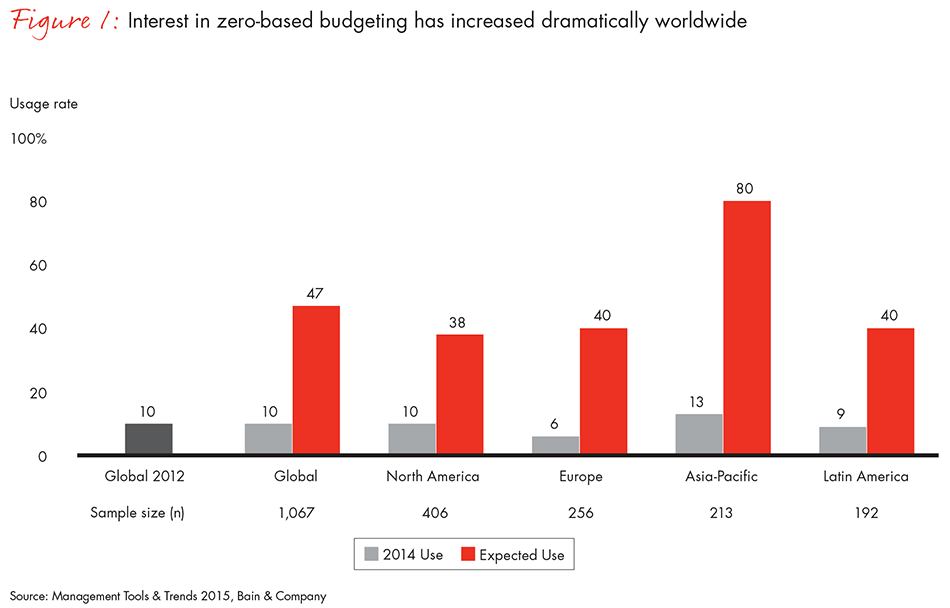
A thoughtfully devised, simpler environment should energize people, enabling them to improve performance and earn financial rewards for their results. Higher employee engagement positions a company to increase both revenues and margins faster than competitors over the long term. But our research has found that zero-based budgeting almost never improves employee engagement. And at some companies, even with a smaller organization, the culture is so ingrained that they need a significant, separate initiative to energize employees.
We analyzed the experiences of 11 large public companies to better understand performance across a trifecta of success metrics: EBIT margin growth, revenue growth and employee engagement (see Figure 2). Eight of those companies outpaced their industry in EBIT margin growth in the six to twelve months after they adopted zero-based budgeting—the best of them by nearly four percentage points. Seven of the companies beat their industry in revenue growth, with the top performer surpassing the average by five percentage points. Yet despite these gains, zero-based budgeting did not inspire employees. We looked at the change in the percentage of employees who recommended the company before and after the implementation, based on data from Glassdoor. Unfortunately, the percentage of employees “recommending the company to a friend” dropped in nine of the eleven cases, by an average of eight percentage points. Based on hundreds of observations on employee engagement, we’ve seen such declines occur as discretionary energy wanes, top talent exits and morale flags.
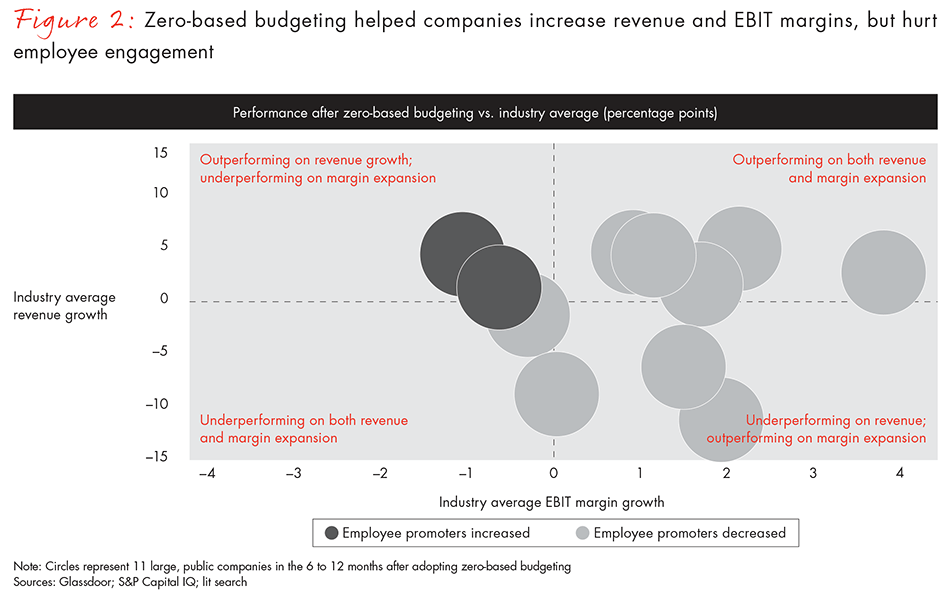
A fundamental shift in thinking
How come it’s so hard to motivate employees—and achieve full potential—following an implementation? Based on our experience, a major reason involves a failure to anticipate and manage the risks. Again, companies often view zero-based budgeting as a nuts-and-bolts cost-reduction exercise. But in reality, it’s a new capability and a catalyst to help restore an ownership culture. Getting the full value requires changing a company’s mindset around two fundamental ideas.
First, instead of treating overheads as expenses, the best companies regard the program as an opportunity to reframe them as a multiyear investment in building assets—the capabilities and human capital—that can deliver a sustained competitive advantage. These companies manage operating expenses (opex) with the same discipline they use to manage capital expenses (capex), and actively distort opex investments to build capabilities that underlie sustainable sources of competitive advantage. This represents a major change in how most companies view operating expenses, and it’s critical for realizing the full power and potential of zero-based budgeting.
Second, companies need to emphasize the central human element of building the organizational muscle for continuous cost improvement. By primarily focusing on the technicalities—cost packages, financial account cleanup, policies and routines, which are essential, but not at all sufficient—the odds of success drop dramatically. Lasting results require a highly collaborative process designed to change long-term behavior and build a new organizational capability—a new culture of owners—and that takes time.
Jason Heinrich, a partner with Bain's Performance Improvement practice, shares the five critical elements for successfully implementing zero-based budgeting.
There’s a lot of strategic power in zero-based budgeting. It ensures that every dollar is a working dollar in service of your strategy. It provides granular visibility into how you spend your fixed overhead dollars and a high-resolution dashboard that strengthens your operational control of those dollars. It forces you to think deeply about strategic priorities, funding those priorities anew every year to make sure that strategy and insight—as opposed to legacy and inertia—are the motivation behind fixed-cost investments.
Moreover, it gives companies a repeatable process to set aggressive, yet achievable, targets, with clear spending policies and a continuous way to scrutinize every dollar of spending. With strong leadership and involvement from the CEO, CFO and CHRO, and an eye toward risk mitigation, zero-based budgeting serves as a catalyst for a cost-conscious cultural transformation. Companies with strong cost cultures in relatively stable industries seeking cuts of 10%–20% can often rely on the savings from traditional cost-optimization programs. However, a broader, zero-based budgeting effort is especially important when the cost ambition is bolder (20%–40% reduction), such as for companies in consolidating industries, in lower-growth environments or in industries facing inflections in the cost experience curve from digital disruption. But zero-based budgeting is not just for challenged businesses; it can be an essential capability for high-growth or innovation-oriented firms looking to maximize and efficiently deploy their scarce resources.
The risk is that there are so many ways to do it wrong. Our work with clients has helped us identify the five biggest ways companies fall short on achieving and sustaining the trifecta and how to overcome them (see Figure 3).
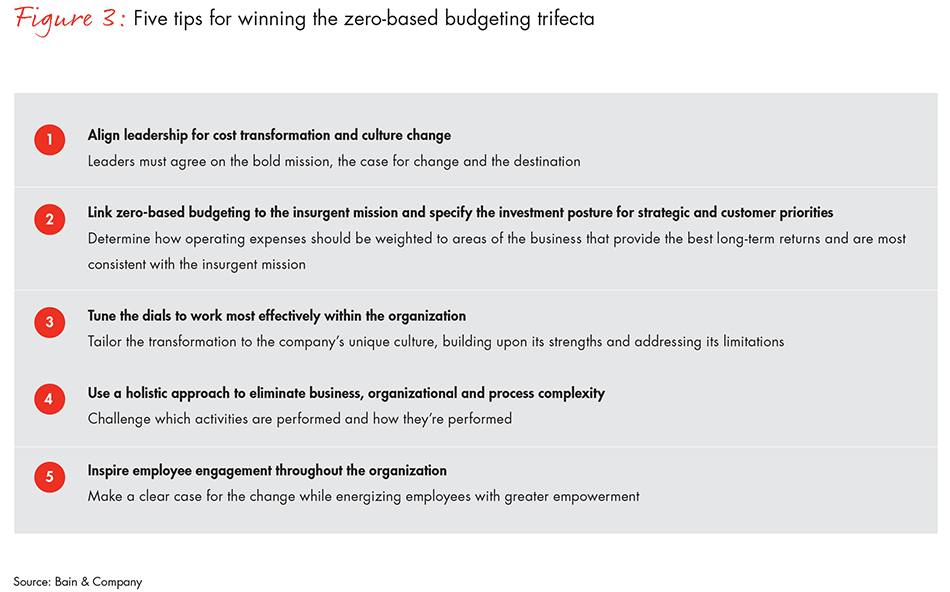
1. They fail to align leadership for cost transformation and culture change
To be successful, companies have to recognize zero-based budgeting capability for what it is: an attempt to significantly change culture and behavior. As with any major change, the leadership team must be aligned on the bold mission, the case for change and the destination: a high-performance culture with an ownership mindset. That’s virtually impossible to do unless it’s a top priority for the CEO and leadership team, and unless they are willing to maintain the commitment over the long term, serving as role models and coaches, and sending clear and consistent messages throughout the organization.
Some companies start the process of creating this alignment by holding what we call intent workshops, with well-trained coaches leading conversations aimed at setting the ambition for zero-based budgeting and customizing the approach. Others have found it invaluable to rely on a CHRO to lead the process of building alignment (see the Bain Brief “The Chief Energy Creator”).
2. They fail to link to the insurgent mission and align the program with strategic priorities
As a practical first step after aligning leadership, companies need to clarify—possibly rediscover—their insurgent mission. Our colleagues Chris Zook and James Allen introduced the concept of the insurgent mission in The Founder’s Mentality: How to Overcome the Predictable Crises of Growth. At its highest level, the insurgent mission answers the fundamental question: Why do we exist? It also articulates the strategy that everybody in the company should be able to describe.
The ultimate purpose of zero-based budgeting must be to fuel that insurgent mission. This requires the company to understand the insurgent mission and the resulting strategy, spelling out how it differentiates the company in the market. Next, the company needs to assess its current and past return on operating expenses to inform savings and investment opportunities. The objective is to determine how to weight opex toward those areas of the business that provide the best long-term returns and are most consistent with the insurgent mission.
From a portfolio perspective, for example, you’ll identify where investments should be pulled back and cost savings realized; where you can more selectively trim cost to improve the return on opex; and where you can boost growth through greater investment in the strategic capabilities needed to achieve differential results.
This investment posture sets the stage for reshaping the profit-and-loss statement, cost structure, operating model and capabilities that will enable the chosen strategy. It positions a company to make better decisions about deploying scarce resources to reinvigorate the insurgent mission and maximize shareholder value. This posture helps leaders agree on such basic decisions as which capabilities need to be best in class—built to enable and sustain competitive advantage—versus best in cost, and how to reinvest potential savings in employees to improve engagement. These decisions determine the design of the zero-based budgeting transformation program.
3. They fail to tune the dials to work most effectively within the organization
Each organization is unique, and to maximize results, a zero-based budgeting transformation must be attuned to a company’s culture, building upon its strengths and addressing its strategy and culture. After the initial steps of setting the ambition and then determining where to differentially invest, through the articulation of an investment posture, a company can turn its attention to the bespoke zero-based budgeting design.
When designing the zero-based budgeting capability, the first critical questions to answer concern the scope of the program. Will it cover the full P&L—including selling, general and administrative expenses and cost of goods sold—or just indirect costs? Will it cover the entire enterprise or just certain parts? Answers to these questions depend on the overall cost ambition, organizational readiness from a leadership and systems perspective, and the degree of change you’re trying to achieve. One company may opt to include all of its costs in all regions, while another may use just a single region. Yet another company may opt to address only indirect spending, omitting direct or variable spending (see Figure 4).
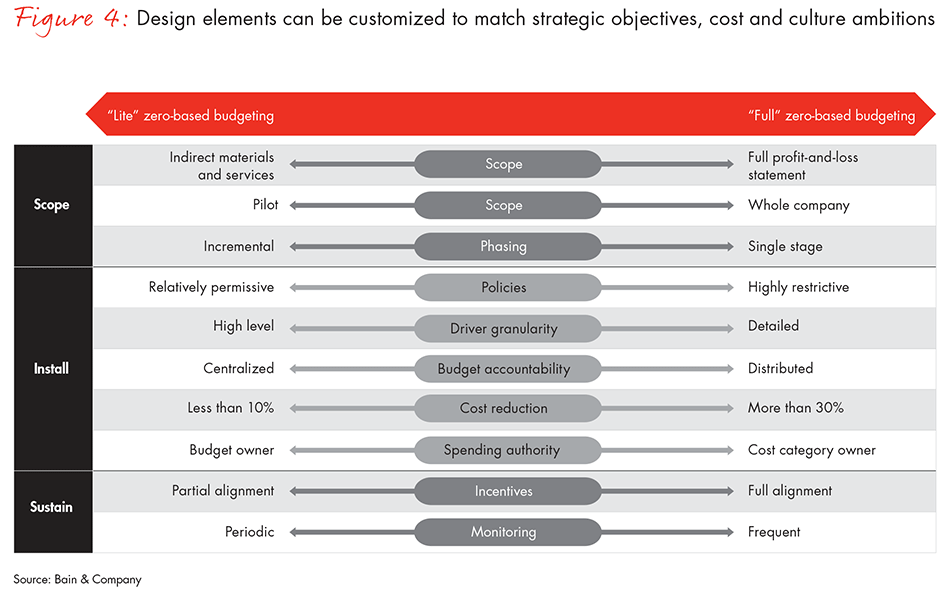
The principles from the first two steps—setting the ambition and determining where to differentially invest—also cascade to the cost-package and budget-center levels so that the right tradeoffs can be made during the budgeting and negotiation process. These principles should inform the cost target at each cell in the matrix of packages and budget centers. This should then pave the way for determining how restrictive to make the policies; how to flow decision rights and accountability into the organization; which packages to manage centrally vs. on a distributed basis; how to link the incentive systems to achieve the best results; and at what level of granularity to budget. Companies don’t need to take a full-throttle approach to every one of these issues; they can install the capabilities and accelerate over time.
4. They fail to use a holistic approach to eliminate business, organizational and process complexity
Zero-based budgeting is highly effective for illuminating opportunities and for scrutinizing every dollar of spending to identify savings and keep costs out. But when organizational and process complexity impede efficiency, zero-based budgeting doesn’t tell you how to take out the cost. To do that, companies need a holistic approach that tackles complexity just as it tackles overconsumption. At its core, reducing complexity means eliminating activities that don’t generate value, thus improving efficiency, rooting out duplication and making sure work is performed in the most appropriate location. When the best companies need structural change to their operating model or breakthrough ideas to simplify their organization, they apply a zero-based mindset to the problem.
In the same way that zero-based budgeting forces companies to scrutinize every dollar of spending, a zero-based redesign enables companies to radically revamp their operating models by analyzing which activities should be performed at what levels and at what frequency. It also helps them examine how they could perform these activities better—potentially through streamlining, standardization, outsourcing, offshoring or automation.
In our experience, zero-basing the work and the operating model are as important as zero-basing the budgets for taking out—and keeping out—cost. If you do not take the work out, resources and costs come back—or critical work will not get done in a sustainable manner. If you do not take the layers out and streamline decision accountabilities, complexity and work come back. Again, we find that the best-in-class companies take a holistic approach (see Figure 5). They reengineer the work to optimize the cost to serve customers. They adapt the operating model to reduce organizational and business complexity, clarify decision making and accountability, and rebalance the portfolio to discontinue dilutive or non-strategic investments. This holistic line of attack delivers a simplified, flatter organization that empowers employees by clarifying the link between individual responsibilities and the most critical value drivers in the business. And with fewer decision makers, ongoing zero-based budgeting becomes that much easier.
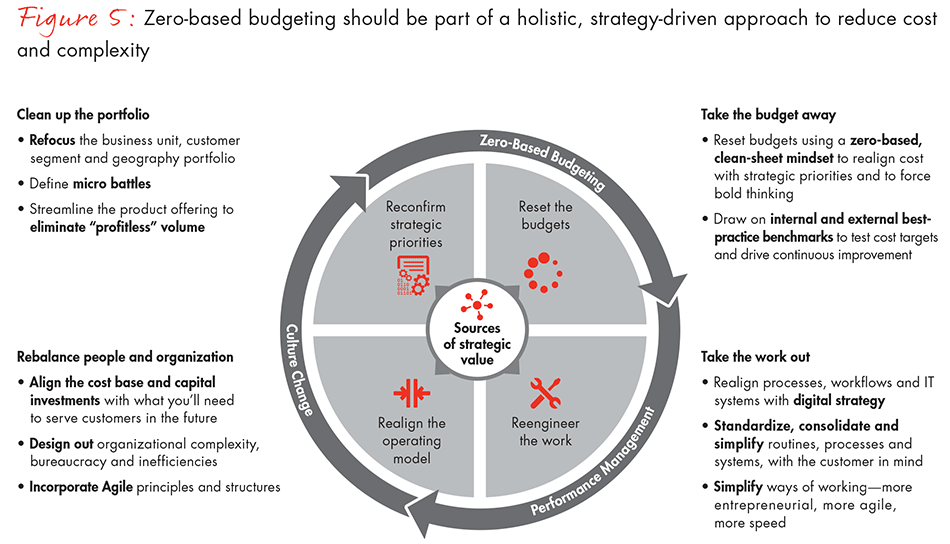
5. They fail to inspire employee engagement throughout the organization
One of the biggest dangers of the approach that many companies take to zero-based budgeting: losing the hearts, minds and energy of their employees. To avoid this, companies need to make a clear case for change, linked to company strategy, and translate it into meaningful behavior change for employees. This helps employees answer the question, “What does it mean for me?” And leaders need to do it while inspiring—not destroying—employee engagement. Tighter travel policies and lower per diems don’t motivate employees. But with greater ownership, empowerment and responsibility, employees can become more engaged to make front-line decisions for the good of the business and customers.
Companies can further improve the employee experience and value proposition by channeling some of the savings back into investment in employees. The best companies track key customer outcomes through a Net Promoter System®, a common gauge of customer advocacy, and an employee Net Promoter System, during major change initiatives. It’s important to have both leading and coincident indicators on the dashboard to take preventive and corrective actions.
Again, the CHRO can play a key role in building lasting engagement at all levels of the organization, generating support from the C-suite, mobilizing momentum in the middle of the organization and changing old habits at the front line. In our experience, the most successful companies also inspire employees to embrace change with a strong sponsorship spine, which cascades program sponsorship to all levels of the organization. These companies don’t design their zero-based budgeting in a back room to be unveiled to the organization as a fait accompli. Instead, they co-create it with key change agents (e.g., the package owners) across the organization—early and often. Zero-based budgeting is not a finance-only exercise. Initiating and sustaining the change requires extending both ownership and incentives deep in the organization. That means enlisting up to 10% of the white collar workforce into the budgeting process.
Sponsors anticipate and mitigate risks, and encourage teams to speak up when they spot barriers to change. By soliciting feedback and celebrating successes, they can establish a fair process that empowers people to contribute bold ideas and communicate progress.
Instead of relying on broadcast communication from the top, change leaders create a companywide dialogue about what is happening. In an enrollment cascade, every individual in the organization hears about the plan from his or her direct supervisor and is invited to ask questions and provide feedback on the spot. The resulting dialogue allows individuals to feel they’ve been heard, and it offers them a greater sense of control. It also sets goals that are more likely to be realistic.
If you implement zero-based budgeting with a full-value mindset and avoid these five pitfalls, it can become a strategic growth tool and culture-changing capability. As such, it’s not merely another way to compress costs. It can lead to a higher percentage of passionate employee promoters. And while the old adage that you can’t cut your way to growth is surely true, failing to invest every dollar strategically and purposefully is the surest way to fail to deliver the full trifecta.
Why now?
Across industries, companies are struggling to meet the new and mounting challenges of digitalization and macroeconomic headwinds. Many are also dealing with a fallout from digitalization itself: prices are dropping at increasing speeds, and companies need to adapt their cost structures to better reflect realistic growth expectations and maintain margins. Meanwhile, the pace of innovation has intensified, and companies need to free up funds for investments that will enable them to stay ahead of competitors. And most companies are in a constant battle with the rising (sometimes hidden) costs of creeping complexity in their organizations. Finally, activist investors are relentlessly pressuring companies to boost shareholder value.
Zero-based budgeting is fundamentally a superior system for cost management and culture change. In fact, it’s hard to imagine that in some form, it’s not the right system for every company. Why? Because it’s really a tool for maximizing visibility and accountability while aligning fixed cost with strategy through resource distortion—you make sure every dollar is a working dollar in service to your strategy.
When most successful, it creates a new culture of ownership within the organization. And feeling like an owner is something that employees can get excited about. Companies can achieve this only through strong leadership, a clear insurgent mission to guide the effort, tuning the dials to a company’s unique needs, a holistic approach that addresses organizational complexity, and an unwavering dedication to keep employees engaged. This is what separates the companies that establish themselves as cost, energy and growth leaders—trifecta winners—from those that reap no more than temporary savings.
Net Promoter System® is a registered trademark of Bain & Company, Inc., Fred Reichheld and Satmetrix Systems, Inc.
Jason Heinrich is a partner in Bain & Company’s Chicago office and a leader in the firm’s Performance Improvement practice. He leads Bain’s Zero-Based Budgeting capability globally. Eric Garton is a Bain partner based in Chicago and leads Bain’s Global Organization practice. Brad Martin is a partner in Bain’s Chicago office and a leader in the firm’s Private Equity practice. He leads Bain’s Zero-Based Budgeting capability in the Americas.




